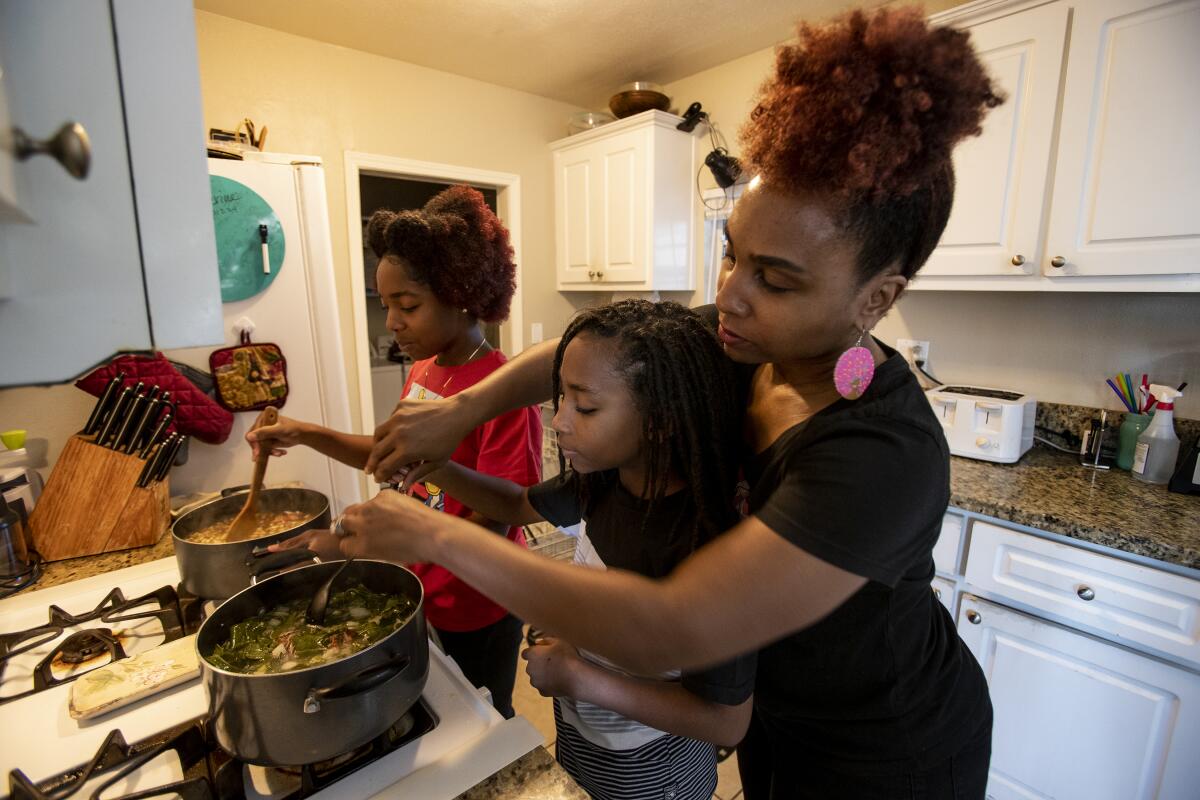For many black families, New Year’s greens and black-eyed peas fill the belly and the soul

- Share via
The smell of garlic and onions filled Layla Sewell’s kitchen in Leimert Park as her 13-year-old daughter, Nailah, added in chopped collard greens. Nearby, Sewell’s 11-year-old son, Taj, trimmed meat off of a smoked turkey bone that will also join the pot in a New Year’s ritual that binds generations of black families through time and distance.
“We cook greens for prosperity and black-eyed peas for good luck,” Sewell, 43, said Wednesday. Later, she covered the black eyed-peas in water and rinsed them off several times before submerging them once more in water and seasonings.
The recipes have been passed down from one Sewell matriarch to the next and even now, though 2,500 miles separate Sewell from her mother in South Carolina, they are connected as they both take part in this age-old tradition.
The dishes that are served at black tables on the first day of the new year not only fill bellies but feed souls.
“It’s a spiritual moment,” Sewell said. “Because it’s a direct connection to my ancestors that I knew and a representation of the ancestors I didn’t know who were before me.”
Different cultures engage in practices steeped in superstition or symbolism in hopes they‘ll bring good luck in the new year.
Some people of Spanish descent eat 12 grapes at the stroke of midnight. Vietnamese culture dictates that debts should be paid off before the Lunar New Year. But for the millions of African Americans spread across the country, the practice of cooking good luck black-eyed peas and prosperity greens is rooted in resiliency and triumph.
There’s much debate about the origins of these New Year’s dishes, said Angela James, a former professor of African American studies at Loyola Marymont University. But they are believed to have originated in the South and may date back to the people of the West Indies who brought the meals when they were enslaved.
The tradition was passed down to Sewell, who traces her lineage to the Geechee people of South Carolina. The enslaved turned out tasty meals from the scraps and undesired cuts of meat tossed aside by slave masters.
Ham hock, or pork knuckle, is often used to flavor the greens. Chitlins, or pig intestines, are cleaned and boiled. Black-eyed peas, which resemble coins in the abstract, are added with mustard, turnip or collard greens, which represent money. The dishes are often served with pork.
As waves of black people migrated from the Deep South, they packed up their traditions and brought them along.
“People cling to these traditions,” James said. “We have a culture where movement — involuntary or voluntary — is a really important part of our history, so you take home with you wherever you go.”
Over the years, these meals that grew out of resourcefulness were adopted as Southern staples. They are sometimes served as hoppin’ John.
At the Albertsons grocery store on Crenshaw Boulevard, long lines snaked through the food aisle Tuesday as shoppers made last-minute trips for their New Year’s feast.
Valicia Logan, 59, had already put a mix of Chinese turnips, mustard and collard greens in a slow cooker. She placed on the conveyor belt a bag of dry black-eyed peas, the star of a family dish that she had watched her relatives create in Hayti, Mo.
“This is all our ancestors had at the beginning of the year,” Logan said.
In a different checkout line, Chris Gardener, 43, held a hand-basket by his side filled with chitlins and hog maws, or pork stomach.
“This is not for me,” he said, pointing to the five-pound block of frozen chitlins. Like the handful of people interviewed with the Southern delicacy in their basket, he added, “I don’t eat this.”
He grabbed a sealed paper bag with fried chicken inside. “Just chicken and bread for me,” he said.
Nickelle Collins, 46, standing behind him added, “If you don’t eat chitlin’ like I don’t, then you can go with the black-eyed peas.”
They can see how black-eyed peas and greens can represent financial fortune and good luck but were perplexed by the chitlins.
Maybe, Collins said, it represents “the creativity.”
Gardener said his mom cooked her black-eyed peas with a dime simmering in the broth. The coin is tossed before the dish is served.
James, the professor, said some black families cook hearty pots of gumbo. Those people normally trace their roots to Louisiana or Texas.
“You almost can tell where people are from by what traditions they observe,” James explained as beads of sweat glistened on her forehead Tuesday.
Moments before, she had been hauling laundry into the washer, cleaning the counters of her View Park home and packing up Christmas decorations.
“You don’t want to go into the new year with all your old dirt and baggage,” she said she learned growing up. “All of that needs to be left behind so you got to make sure everything is clean. You have to hit the reset button.”
It was not passed down with a history lesson. It was lived, she said.
Freshly washed clothes and linen represent a blank slate. A new start.
With her black-eyed peas and greens cooking in the slow cooker Tuesday night, James added a new twist to the tradition.
She was heading out to the Korean spa.
“I like me to be totally clean, too,” she said.
More to Read
Sign up for Essential California
The most important California stories and recommendations in your inbox every morning.
You may occasionally receive promotional content from the Los Angeles Times.











